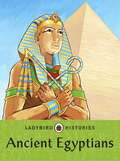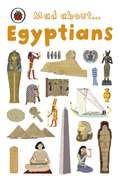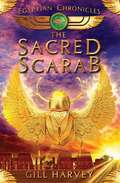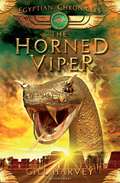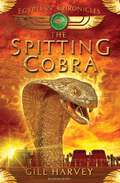Special Collections
Excellent Egyptians
Description: Accessible images and books for special topics
- Table View
- List View
Ladybird Histories
by Brian and Brenda WilliamsThis Ladybird Histories ebook all about Ancient Egypt is perfect for all children learning about Ancient Egypt and the Egyptians at school, including Ancient Egypt's kings and queens, how ancient Egyptians lived and why they believed in mummification and different Egyptian gods. Packed full of interesting and entertaining details that will delight all readers - from lifestyles, battles, and important characters to the influence the past has played on the world around us today. Everything you need to know about Ancient Egypt for school homework!Ladybird Histories is a series of ebooks about periods and people in history that children find especially engaging. Look out for other titles in the series: Tudors and Stuarts
Mad About Egyptians
by Ladybird BooksAre you mad about Egyptians? From masks and mummies to pharoahs and pyramids, this book is perfect for all ancient Egypt enthusiasts. Ladybird's Mad About series is all about giving its readers all the facts they could possibly need about their favourite subjects. Get ready to impress all your friends with all your new knowledge!
Egyptian Hieroglyphic Grammar
by Gunther RoederWritten and spoken for about 4,000 years, Egyptian is no longer a living language (Arabic is the major language of modern Egypt); however, ancient Egyptian is still studied by Egyptologists, historians, archaeologists, and students interested in the age-old civilization along the Nile.Typically, students of ancient Egyptian begin with Middle, or Classical, Egyptian, which was written in hieroglyphic script. Middle Egyptian is especially important because it is the language in which many important literary works were written. Moreover, when it was no longer spoken, Middle Egyptian continued to be taught in temples and schools as a vehicle of literary and liturgical expression.This compact handbook, by a noted German Egyptologist, was specially designed for beginning students who wish to acquire enough basic knowledge to enable them to read the easier hieroglyphic texts. Toward that end, the author begins with a general discussion of Middle Egyptian and its script, followed by concise, accessible lessons in phonology, formation and usage of nouns and other parts of speech, and syntax. With careful study, the student should be able, even after the first lesson, to translate simple sentences independently. A list of hieroglyphs, a vocabulary section, and reading exercises complete this handy manual that offers students quick and easy access to the language and culture of ancient Egypt.
An Ancient Egyptian tomb (UEB uncontracted)
by RnibThis is image is a plan view of a typical Egyptian tomb showing an annexe, a treasure room, antechamber and burial chamber. There is a locator dot shown, which will be at the top left of the page when the image is the right way up. The plan is bounded by a dashed line image border. On the bottom left of the page is the entrance into an antechamber filled with treasures and artefacts. At the top left of the page is an annexe with more valuable objects. At the right side of the antechamber there are two statues of the king and to the right of these is the entrance to the burial chamber containing the coffin. The wall to the right of the coffin is decorated. At the bottom right of the page is a treasure room with a golden shrine and an image of Anubis, god of the funeral cult and carer for the dead.
Egyptian god Amun Ra (UEB uncontracted)
by RnibThis picture shows Ra the sun god in one of his many forms with the head of a falcon and the body of a man. There is a locator dot shown, which will be at the top left of the page when the image is the right way up. He is standing with his head and legs facing to the right, so only one eye can be seen. His arms and chest are facing forward. At the top of the page Ra is wearing the Uraeus, a headdress symbolising the goddess Wadjit in the form of a cobra with its head to the right, draped over the sun-disc. Down the page from this is Ra's falcon head with its one visible eye and beak to the right with his long hair to the left. He is wearing a wide ornamental Egyptian collar. In the middle of the page is Ra's chest facing forward with a hand on the left pointing down and holding an Ankh. His other hand, on the right holds the staff of life. He wears two bracelets on each of his arms and a gold band around his chest. Around his waist is a short kilt reaching down to his knees and down from this can be found two anklets with his feet below them pointing to the right.
The Sacred Scarab
by Gill HarveyThe third in a new series of four books: the first and second titles were published in August and October 2009, the fourth to be published in April 2010.Fantastically atmospheric evocations of Egyptian life are encased in an exciting adventure story. Each story features the boy and girl characters Hopi and Isis, and their struggles for existence and adventure in Egypt circa 1150 BC. In this story, The Sacred Scarab, Hopi and Isis, orphaned when crocodiles kill their parents, are preparing for an important festival, in which the king accompanies the gods to his great mortuary temple. But when Isis and Hopi uncover a plot by a villainous tax collector, they need to ensure that justice is done . . . The author has spent much time in Egypt and the stories are meticulously researched.The books include factual detail and notes about Egyptian lifestyle, the importance of the gods for the Egyptians, the tombs and much more.
Egyptian dwarf god Bes (UEB Contracted)
by Rnib BookshareThis is an image of the god Bes known as the protector of childbirth and children. There is a locator dot shown, which will be at the top left of the page when the image is the right way up. He is standing facing forward so all of his face and limbs can be seen. At the top centre of the page is Bes's tall hat with lines running vertically down it. Down the page from this are his eyebrows, two eyes, nose, mouth and beard. His very large ears stick out to either side of his large head. He does not have any neck so that his arms, held outwards with two bracelets on each, appear to grow out of his head. On his chest, he wears an Ankh symbol, thought to represent eternal life and life after death. It is hanging on a necklace, which is not shown. Further down the page are Bes's naval, a loincloth and his two short legs.
Egyptian dwarf god Bes (large print)
by Rnib BookshareThis is an image of the god Bes known as the protector of childbirth and children. There is a locator dot shown, which will be at the top left of the page when the image is the right way up. He is standing facing forward so all of his face and limbs can be seen. At the top centre of the page is Bes's tall hat with lines running vertically down it. Down the page from this are his eyebrows, two eyes, nose, mouth and beard. His very large ears stick out to either side of his large head. He does not have any neck so that his arms, held outwards with two bracelets on each, appear to grow out of his head. On his chest, he wears an Ankh symbol, thought to represent eternal life and life after death. It is hanging on a necklace, which is not shown. Further down the page are Bes's naval, a loincloth and his two short legs.
Egyptian dwarf god Bes (UEB Uncontracted)
by Rnib BookshareThis is an image of the god Bes known as the protector of childbirth and children. There is a locator dot shown, which will be at the top left of the page when the image is the right way up. He is standing facing forward so all of his face and limbs can be seen. At the top centre of the page is Bes's tall hat with lines running vertically down it. Down the page from this are his eyebrows, two eyes, nose, mouth and beard. His very large ears stick out to either side of his large head. He does not have any neck so that his arms, held outwards with two bracelets on each, appear to grow out of his head. On his chest, he wears an Ankh symbol, thought to represent eternal life and life after death. It is hanging on a necklace, which is not shown. Further down the page are Bes's naval, a loincloth and his two short legs.
The Horned Viper
by Gill HarveyThe Horned Viper is the second in a new series of four books set in ancient Egypt.Each book is a well researched and atmospheric evocation of Egyptian life encased in an exciting adventure story. The boy and girl characters, Hopi and Isis, feature in each book and readers will be intrigued to follow their struggles for existence and adventure in Egypt circa 1150 BC.In this story, The Horned Viper, Hopi and Isis, orphaned when crocodiles kill their parents, travel along the River Nile and pit their wits against dangerous enemies. Can they solve the web of intrigue before their boat journey ends? Especially as the powerful Nubian fan-bearer has chosen Hopi as his particular enemy . . .
The Spitting Cobra
by Gill HarveyThe Spitting Cobra is the first in a new series of four books set in ancient Egypt. Each book is a fantastically atmospheric evocation of Egyptian life encased in an exciting adventure story. The boy and girl characters, Hopi and Isis, feature in each book and readers will be intrigued to follow their struggles for existence and adventure in Egypt circa 1150 BC.The Spitting Cobra opens the series with a gripping adventure of royal proportions as Hopi and Isis, orphaned when crocodiles kill their parents, are due to perform for the Pharoah's tomb builders near the legendary Valley of the Kings. But the villagers fall under suspicion when the heavily guarded royal tombs are broken into. Can Isis and Hopi discover the truth about the robberies - in time?
Egyptian god Amun Ra (large print)
by RnibThis picture shows Ra the sun god in one of his many forms with the head of a falcon and the body of a man. There is a locator dot shown, which will be at the top left of the page when the image is the right way up. He is standing with his head and legs facing to the right, so only one eye can be seen. His arms and chest are facing forward. At the top of the page Ra is wearing the Uraeus, a headdress symbolising the goddess Wadjit in the form of a cobra with its head to the right, draped over the sun-disc. Down the page from this is Ra's falcon head with its one visible eye and beak to the right with his long hair to the left. He is wearing a wide ornamental Egyptian collar. In the middle of the page is Ra's chest facing forward with a hand on the left pointing down and holding an Ankh. His other hand, on the right holds the staff of life. He wears two bracelets on each of his arms and a gold band around his chest. Around his waist is a short kilt reaching down to his knees and down from this can be found two anklets with his feet below them pointing to the right.
An Ancient Egyptian tomb (UEB contracted)
by RnibThis is image is a plan view of a typical Egyptian tomb showing an annexe, a treasure room, antechamber and burial chamber. There is a locator dot shown, which will be at the top left of the page when the image is the right way up. The plan is bounded by a dashed line image border. On the bottom left of the page is the entrance into an antechamber filled with treasures and artefacts. At the top left of the page is an annexe with more valuable objects. At the right side of the antechamber there are two statues of the king and to the right of these is the entrance to the burial chamber containing the coffin. The wall to the right of the coffin is decorated. At the bottom right of the page is a treasure room with a golden shrine and an image of Anubis, god of the funeral cult and carer for the dead.
An Ancient Egyptian tomb (large print)
by RnibThis is image is a plan view of a typical Egyptian tomb showing an annexe, a treasure room, antechamber and burial chamber. There is a locator dot shown, which will be at the top left of the page when the image is the right way up. The plan is bounded by a dashed line image border. On the bottom left of the page is the entrance into an antechamber filled with treasures and artefacts. At the top left of the page is an annexe with more valuable objects. At the right side of the antechamber there are two statues of the king and to the right of these is the entrance to the burial chamber containing the coffin. The wall to the right of the coffin is decorated. At the bottom right of the page is a treasure room with a golden shrine and an image of Anubis, god of the funeral cult and carer for the dead.
Egyptian dwarf god Bes (UEB contracted)
by RnibThis is an image of the god Bes known as the protector of childbirth and children. There is a locator dot shown, which will be at the top left of the page when the image is the right way up. He is standing facing forward so all of his face and limbs can be seen. At the top centre of the page is Bes's tall hat with lines running vertically down it. Down the page from this are his eyebrows, two eyes, nose, mouth and beard. His very large ears stick out to either side of his large head. He does not have any neck so that his arms, held outwards with two bracelets on each, appear to grow out of his head. On his chest, he wears an Ankh symbol, thought to represent eternal life and life after death. It is hanging on a necklace, which is not shown. Further down the page are Bes's naval, a loincloth and his two short legs.
Egyptian dwarf god Bes (large print)
by RnibThis is an image of the god Bes known as the protector of childbirth and children. There is a locator dot shown, which will be at the top left of the page when the image is the right way up. He is standing facing forward so all of his face and limbs can be seen. At the top centre of the page is Bes's tall hat with lines running vertically down it. Down the page from this are his eyebrows, two eyes, nose, mouth and beard. His very large ears stick out to either side of his large head. He does not have any neck so that his arms, held outwards with two bracelets on each, appear to grow out of his head. On his chest, he wears an Ankh symbol, thought to represent eternal life and life after death. It is hanging on a necklace, which is not shown. Further down the page are Bes's naval, a loincloth and his two short legs."
Egyptian dwarf god Bes (UEB uncontracted)
by RnibThis is an image of the god Bes known as the protector of childbirth and children. There is a locator dot shown, which will be at the top left of the page when the image is the right way up. He is standing facing forward so all of his face and limbs can be seen. At the top centre of the page is Bes's tall hat with lines running vertically down it. Down the page from this are his eyebrows, two eyes, nose, mouth and beard. His very large ears stick out to either side of his large head. He does not have any neck so that his arms, held outwards with two bracelets on each, appear to grow out of his head. On his chest, he wears an Ankh symbol, thought to represent eternal life and life after death. It is hanging on a necklace, which is not shown. Further down the page are Bes's naval, a loincloth and his two short legs.
Egyptian god Amun Ra (UEB contracted)
by RnibThis picture shows Ra the sun god in one of his many forms with the head of a falcon and the body of a man. There is a locator dot shown, which will be at the top left of the page when the image is the right way up. He is standing with his head and legs facing to the right, so only one eye can be seen. His arms and chest are facing forward. At the top of the page Ra is wearing the Uraeus, a headdress symbolising the goddess Wadjit in the form of a cobra with its head to the right, draped over the sun-disc. Down the page from this is Ra's falcon head with its one visible eye and beak to the right with his long hair to the left. He is wearing a wide ornamental Egyptian collar. In the middle of the page is Ra's chest facing forward with a hand on the left pointing down and holding an Ankh. His other hand, on the right holds the staff of life. He wears two bracelets on each of his arms and a gold band around his chest. Around his waist is a short kilt reaching down to his knees and down from this can be found two anklets with his feet below them pointing to the right.
Egyptian Gallery
by RnibPart of of a wall mural in the Egyptian Gallery, Ipswich Museum; this scene is 39 cm high and 42 cm wide. This is a military scene showing three identical soldiers marching towards a more senior soldier who is standing in front of them. What is significant about the senior soldier is that he has his right arm missing below his elbow showing that a person with a limb missing in Ancient Egypt still was able to play an important role and was not considered "disabled". The three soldiers, facing to the right are shown with bare feet striding towards the senior soldier, their left legs forward with their right feet bent at the toes in movement. They have dark brown skin, black hair and are wearing white kilts with large pleated front decoration. They have a fearsome expression on their faces. In their left hands they hold a long spear with a pointed tip and in their right hands they hold large oval shields with a straight bottom edge. The shields look like they are covered in oxen skin as they have white with brown markings like the oxen in the river as described in 5 above. The senior soldier is standing facing you with his legs apart and with bare feet. He is wearing a knee-length white kilt with a pleated front and a T-shirt style white top. His tummy slightly bulges over his kilt showing that he is well fed. He has a bald head and has a proud look on his face as he admires the other soldiers, perhaps because he is responsible for how they look and their training. His left hand is held at his chest just below a large amulet that is around his neck like a necklace. The stump of his right arm is held away from his body so that we can clearly see that the lower part is missing. The tactile image shows the senior soldier and just one of the other soldiers as they are all identical. The figures are roughly half the size of those in the actual painting. The two figures are shown in outline with no texture for their skin and a texture for their clothing. The spear, hair and outline of the shield are shown as solid texture with a different texture for the body of the shield.
Egyptian Gallery
by RnibPart of a wall mural in the Egyptian Gallery, Ipswich Museum; this section is 111 cm long and 48 cm high. This is a scene of everyday life in Ancient Egypt of two men - one kneeling and one standing - on a papyrus raft trying to prevent a crocodile from getting near to their two oxen that they are driving across the river. The structure of the raft can be seen - stems of papyrus bound together with ropes to form a floating wide 'u' shaped platform with each end raised out of the water. Both men hold long poles with 'y' shaped ends that they are pushing down towards the large crocodile that has its mouth open showing its fearsome teeth. Both are looking down directly at the crocodile with determined looks on their faces. The two oxen, standing side by side with water up to their bellies, are directly in front of the raft and have huge horns typical of Egyptian cattle. The ox nearest the crocodile has its head turned towards it with an expression of fear. The Nile is painted blue with vertical zigzag dark blue lines. The raft is green with darker green for the binding ropes. The men have dark brown skin. The kneeling man is wearing a white kilt and a white headdress that completely covers his hair. The standing man also wears a white kilt but has no headdress and his black hair looks ruffled. Both have bare feet. The oxen have light brown horns with white bodies, one with black spotty markings and the other with brown. The tactile image is four and a quarter times smaller than the actual scene and follows the lines and shapes as closely as possible. The raft, poles, horns, teeth of crocodile and hair of standing man are shown with solid texture. The oxen and crocodile are shown in outline infilled with two different textures. The men are also shown in outline with no texture for their skin and a third texture for their kilts. The kneeling man's headdress is shown with the same texture as the crocodile. Thin lines show the zigzag lines of the river.
Egyptian goddess Isis (UEB uncontracted)
by RnibThis picture shows Isis, the goddess of motherhood and childbirth and the mother of Horus. There is a locator dot shown, which will be at the top left of the page when the image is the right way up. She is standing with her head and legs facing to the right so only one eye can be seen. Her arms and chest are facing forward. At the top of the page is Isis's headdress with two horns. Down the page a vulture is sitting on her head with its beak to the right. Down again is her face looking to the right with one eye, nose and mouth to the right and hair to the left. Around her neck she is wearing a wide Egyptian collar. In the middle of the page Isis's chest can be found. She has an arm with hand raised on the right, and to the left she holds an Ankh. She wears bracelets on her arms and wrists. Isis is wearing a long dress that covers her chest and goes down the page to her ankles. Her two feet are at the bottom of the page facing to the right.
Egyptian goddess Bastet (UEB uncontracted)
by RnibThis picture shows the cat-goddess Bastet. There is a locator dot shown, which will be at the top left of the page when the image is the right way up. She was protector of the pharaoh and the sun god Ra, sometimes known as the Eye of Ra. She is standing with her head and legs facing to the right so only one eye can be seen. Her arms and chest are facing forward. At the top of the page is Bastet's cat ear. Down the page is her head with one eye, cat nose and mouth visible to the right, and her long hair to the left. She wears a wide, heavy Egyptian collar and a long dress reaching down to her ankles with decorative trim at the bottom. Her chest faces forwards and she has one hand held up to the right, with the other to the left, holding a staff with an Ankh symbol on.
Egyptian goddess Isis (UEB Contracted)
by Rnib BookshareThis picture shows Isis, the goddess of motherhood and childbirth and the mother of Horus. There is a locator dot shown, which will be at the top left of the page when the image is the right way up. She is standing with her head and legs facing to the right so only one eye can be seen. Her arms and chest are facing forward. At the top of the page is Isis's headdress with two horns. Down the page a vulture is sitting on her head with its beak to the right. Down again is her face looking to the right with one eye, nose and mouth to the right and hair to the left. Around her neck she is wearing a wide Egyptian collar. In the middle of the page Isis's chest can be found. She has an arm with hand raised on the right, and to the left she holds an Ankh. She wears bracelets on her arms and wrists. Isis is wearing a long dress that covers her chest and goes down the page to her ankles. Her two feet are at the bottom of the page facing to the right.
Egyptian goddess Bastet (UEB Contracted)
by Rnib BookshareThis picture shows the cat-goddess Bastet. There is a locator dot shown, which will be at the top left of the page when the image is the right way up. She was protector of the pharaoh and the sun god Ra, sometimes known as the Eye of Ra. She is standing with her head and legs facing to the right so only one eye can be seen. Her arms and chest are facing forward. At the top of the page is Bastet's cat ear. Down the page is her head with one eye, cat nose and mouth visible to the right, and her long hair to the left. She wears a wide, heavy Egyptian collar and a long dress reaching down to her ankles with decorative trim at the bottom. Her chest faces forwards and she has one hand held up to the right, with the other to the left, holding a staff with an Ankh symbol on.
Egyptian god Osiris (UEB Contracted)
by Rnib BookshareThis is an image of Osiris; judge of the dead and also god of rebirth, he exerted his power over the flooding of the river Nile and the greening of Egypt. There is a locator dot shown, which will be at the top left of the page when the image is the right way up. He is standing with his head and legs facing to the right, so only one eye can be seen. His arms and chest are facing forward. At the top of the page is Osiris's conical crown with red plumes to either side. Down the page from this is his head with one eye, nose, mouth and beard visible to the right. His skin is green. Around his neck, he wears an ornamental Egyptian collar of red and blue. Down the page his abdomen is facing forward with his elbows extending out on both sides. His hands are on his chest; the one on the left holds a flail and the one on the right a crook. Down the page Osiris wears a sash around his waist. He is wrapped to the ankles in strips of linen similar to a mummy and has green feet facing to the right.
